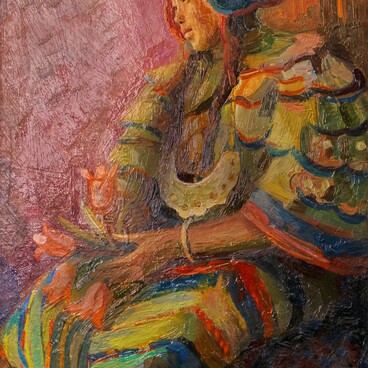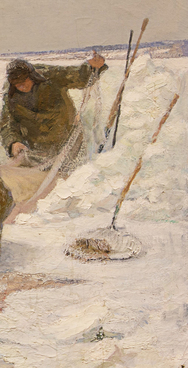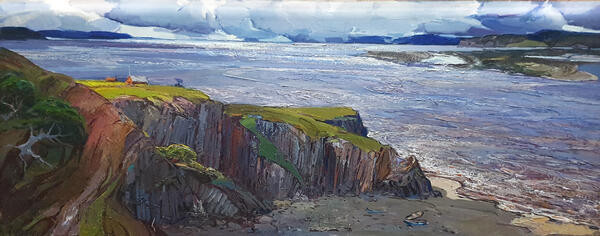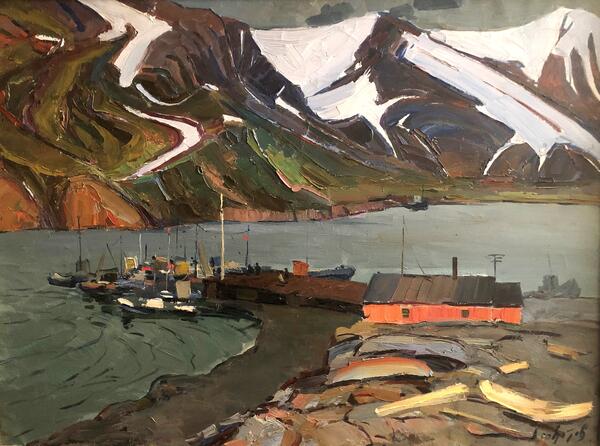Historians of the Russian Far Eastern art developed a concept of the “Fedotov landscape”. It is associated with a talented landscape painter Alexey Matveyevich Fedotov.
Alexey Matveyevich Fedotov (1919–1985) was an oil painter and depicted landscapes of the Russian Far East. Alexey was born in the Katarbey village of the Nizhneudinsk district in the Transbaikal region, into an ordinary family of Siberian workers. The artist’s creative legacy can be divided into two major periods, dedicated to Transbaikal and Khabarovsk.
In 1958, Alexey Fedotov came to Khabarovsk and discovered the beauty and bounty of Far Eastern nature. Then, the second, very productive period of his artistic journey started. The paintings, created during that time, are dedicated to the Russian Far East and Siberia. Alexey Fedotov was enthralled by the impressive scale of those lands, the endless mountains and hills, the spurs and gorges. His trips around the Amur, Baikal, Primorye, Kamchatka, Sakhalin and Kolyma territories resulted in a large number of studies, many of which hold their own artistic value.
In his landscapes, Fedotov seemed to try to fit the infinite space with all its transitions of color into just one canvas. He masterfully used broad impasto brushstrokes to convey the greatness of nature without confining it.
In the painting “Autumn in the Mountains”, Far Eastern nature is depicted in its fleeting but memorable beauty. Fedotov used a bright autumn palette and a balance of soft terracotta, yellow, milky-blue, purple and marsh-green hues to make the painting livelier and more dynamic.
The viewer’s attention is drawn by the thin tree trunks in the foreground, serving as a reminder of the fragile and yet generous nature of all living beings: the rocky ledge holds birches, spruces, pines, and golden-crowned aspens. The second, middle ground depicts the full-flowing winding mountain river. The background shows majestic valleys of hills, each of them with its own “face” and personality. By this, the artist tells the viewer — nature never repeats itself, and neither should an artist.
For a long time, Fedotov’s paintings were part of the so-called gift fund for the honored guests of exhibitions and the city. The artist himself was known to willingly give away his works. At Fedotov’s posthumous personal exhibition in 1989, over 300 of his works were presented, which were collected from museums and private collections, hotels, community centers, cinemas, and other public organizations. In 1993, the Exhibition Hall of the Khabarovsk Branch of the Artists’ Union was renamed the Alexey Fedotov Art Gallery.
Alexey Matveyevich Fedotov (1919–1985) was an oil painter and depicted landscapes of the Russian Far East. Alexey was born in the Katarbey village of the Nizhneudinsk district in the Transbaikal region, into an ordinary family of Siberian workers. The artist’s creative legacy can be divided into two major periods, dedicated to Transbaikal and Khabarovsk.
In 1958, Alexey Fedotov came to Khabarovsk and discovered the beauty and bounty of Far Eastern nature. Then, the second, very productive period of his artistic journey started. The paintings, created during that time, are dedicated to the Russian Far East and Siberia. Alexey Fedotov was enthralled by the impressive scale of those lands, the endless mountains and hills, the spurs and gorges. His trips around the Amur, Baikal, Primorye, Kamchatka, Sakhalin and Kolyma territories resulted in a large number of studies, many of which hold their own artistic value.
In his landscapes, Fedotov seemed to try to fit the infinite space with all its transitions of color into just one canvas. He masterfully used broad impasto brushstrokes to convey the greatness of nature without confining it.
In the painting “Autumn in the Mountains”, Far Eastern nature is depicted in its fleeting but memorable beauty. Fedotov used a bright autumn palette and a balance of soft terracotta, yellow, milky-blue, purple and marsh-green hues to make the painting livelier and more dynamic.
The viewer’s attention is drawn by the thin tree trunks in the foreground, serving as a reminder of the fragile and yet generous nature of all living beings: the rocky ledge holds birches, spruces, pines, and golden-crowned aspens. The second, middle ground depicts the full-flowing winding mountain river. The background shows majestic valleys of hills, each of them with its own “face” and personality. By this, the artist tells the viewer — nature never repeats itself, and neither should an artist.
For a long time, Fedotov’s paintings were part of the so-called gift fund for the honored guests of exhibitions and the city. The artist himself was known to willingly give away his works. At Fedotov’s posthumous personal exhibition in 1989, over 300 of his works were presented, which were collected from museums and private collections, hotels, community centers, cinemas, and other public organizations. In 1993, the Exhibition Hall of the Khabarovsk Branch of the Artists’ Union was renamed the Alexey Fedotov Art Gallery.




